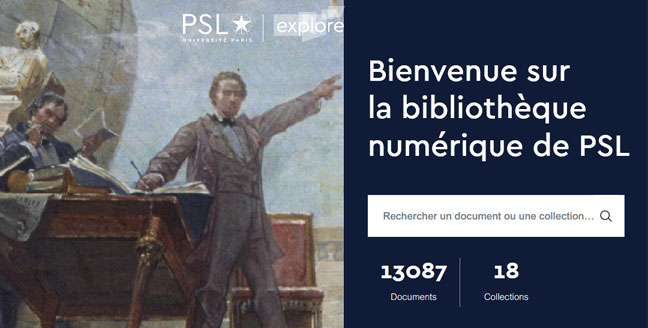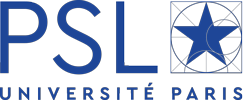A heritage digital library that showcases PSL’s wealth of document resources
Offering correspondence, course lectures, drawings, videos, photographs, scientific instruments and more, PSL’s heritage digital library is home to a treasure trove of resources and now offers a new browsing interface that is simpler and more user-friendly.

From the scientific research of Prince Albert 1st of Monaco to the archives of architect and designer René Gabriel, the collection of the Laboratoire Curie, lectures by painter Jean-François Debord and (soon) the archives of scientist Paul Langevin, PSL’s heritage digital library offers a transdisciplinary journey through the exceptional document resources of PSL’s member schools.
“Heritage digital libraries often display the history of an institution, a city or a region,” says Anne-Marie Turcan-Verkerk, Research Director at EPHE–PSL, who directs PSL’s programs for documentation and knowledge dissemination. “Ours at PSL reflects the richness of our member schools. It offers a pandisciplinary perspective that is fairly unusual for a university digital library, much like our unique intellectual heritage.”
PSL’s digital library, which went online in 2015, consists of 18 highly diverse collections (scientific instruments, illustrations from the Radium Institute, archaeological collections, etc.) that serve as world-class scientific resources for students, researchers or Internet browsers who want to learn about the history of science, design, astronomy, the arts and much more.
In 2020 the digital library’s website has been completely redesigned, both in appearance and features, to make it easier to use and provide maximum support for scientific projects. These days, web users expect to get clear, filtered search results in a matter of seconds. So the digital library was reorganized with three primary objectives in mind: strengthen the search engine, improve the site’s overall appearance and user-friendliness, and incorporate new features designed to aid research.
The project was overseen by Elisa Thomas, the digital library’s director. “Digital libraries are complicated projects, and unfortunately it’s all too common to see scientific resources housed on sites that are difficult to use,” she says. “In our view, it was essential to help researchers do their work by offering them a seamless, attractive interface and efficient, practical research tools. We also revamped the site navigation to highlight our various collections more effectively and encourage exploration and discovery.”
The digital library has been significantly enhanced with improved functions such as filtering by subject matter, research topic or type of document. Users can also share document records on social media or websites, and they now have an easy way to generate a list of bibliographical references or save bibliographical data.
![Schaeffer, Claude Frédéric-Armand, “[Ras Shamra 1960 inventaire depuis 23.483 à 23.741]”](/sites/default/files/2020-10/actuweb_bib_num-2_1.jpg)
Researchers will now find it a much simpler task to access the 18 collections and more than 13,000 documents (videos, archive photos, correspondence, etc.). This document corpus was made possible by calls for proposals led or supported by PSL-Explore, working in close collaboration with the libraries and heritage collections of PSL’s member schools since 2015. That collective momentum led to a number of large-scale projects, such as a campaign to digitize Jean-François Debord’s morphology lectures at the Beaux-Arts de Paris and make them available to the public. It’s also given greater visibility to some collections that had been overlooked, such as the complete archive of architect and designer René Gabriel’s working documents, housed at ENSAD. Preparing digital collections is an arduous task,” says Elisa Thomas. “Each document is inventoried, described and measured, and in some cases restored, prior to being digitized. Then it’s inspected once again, packed and returned to its original collection. Moreover, when we publish documents online we also have to address the issue of distribution and rights.”
The library expects to acquire new collections in the near future, including a collection of audio recordings of lectures given at the Beaux-Arts de Paris, the archives from the conservation center of the French School of Asian Studies (EFEO) in Angkor, and complete documentation in pictures of an important archaeological site in Syria, now destroyed (the REVIS project). In addition, the papers of Paul Langevin, the great scientist and true humanist, will soon be placed on line, introducing his work to a wider audience.
The Paul Langevin papers
Paul Langevin (1872–1946) is an iconic figure in early 20th-century science. As a professor at the Collège de France and director of ESPCI, he holds a unique place in the history of physics over the past 100 years, having played a critical role in major theoretical breakthroughs (electron theory, relativity, magnetism and statistical physics) and technical innovations (among other things, he was the inventor of sonar).
A passionate pacifist and committed humanist, he devoted much of his life to reflecting on the aims of scientific endeavor and how they should be taught. As a signer of the petition to exonerate Alfred Dreyfus, he was actively involved in contemporary movements to protest the rise of nationalism in France, both as founding member of the Watchfulness Committee of Antifascist Intellectuals and as Vice President of the Human Rights League of France. Throughout his life, he worked to disseminate knowledge and new pedagogical methods as the president of the French Group for New Education (GFEN), the founder of the Workers University of Paris and, near the end of his life, president of the Langevin-Wallon Commission for educational reform.
“The Paul Langevin archives, generously entrusted to ESPCI ParisTech–PSL by his family, coupled with documents relating to Langevin’s career as the chair in physics at the Collège de France, comprise an exceptional collection of nearly 8,000 items,” says Catherine Kounelis, Library Director at ESPCI ParisTech–PSL. “They include documents of enormous scientific value, such as his correspondence with elite scientists of his day, including Wolfgang Pauli, Ernest Rutherford, Marie Curie, Louis de Broglie, Frédéric Joliot-Curie and Albert Einstein. All of those documents have been digitized with the approval of the rights holders and are available in PSL’s digital library. They are an invaluable primary resource for students, researchers and anyone who wants to know more about the life and work of Paul Langevin.”
